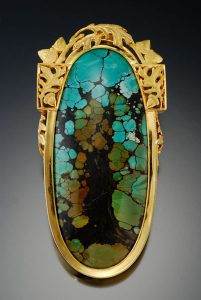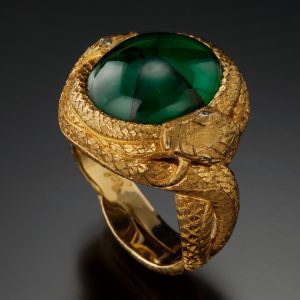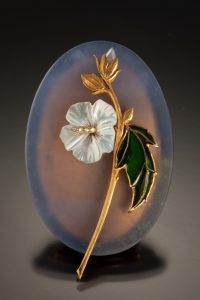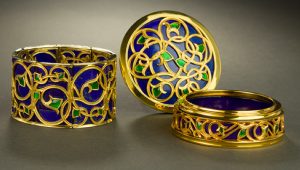Tom Herman: Humble Beginnings to Masterful Artistry
Growing up in small towns, Tom Herman shares the story of his humble upbringing, and how that has inspired his attitude towards jewelry making. Thrust into the world of jewelry, Tom has spent years learning and mastering his craft. His works reflect his interests, such as the Art Nouveau movement, and the nature he was surrounded by as a child. He speaks further about his education and craft in the interview.
Your biography mentions that you were always artistic growing up. What made you want to use these artistic skills for jewelry making?
I grew up on a farm in Minnesota, and in the small town of Van Meter in Iowa; I was one of nine kids. We didn’t have money for lots of extra things, so we made do and often made what we wanted. We built our own toys. We repaired and built bikes, slingshots, fishing poles and anything we needed to camp by the river in the summer – sometimes for weeks at a time. Necessity is the mother of invention and can begin the building of creative and artistic skills. The school in Van Meter is a K-12 school. Every student had an art class every year, shop class and home economics each year after sixth grade. In high school, I mostly did pottery. In 1979 I opened a small shop in Iowa City, Iowa, where I was going to sell my pottery,

Turquoise Oak Brooch by Tom Herman. Featuring turquoise, set in 18K gold
[though] because it was a jewelry shop before I got it, people kept stopping in asking for jewelry and jewelry repairs. I decided to try making a few of the orders, and they sold. After about six months, I realized I enjoyed making the jewelry. It seemed to sell better than the pottery, so I started to focus on jewelry.
In a few words, how would you describe your jewelry?
My work is naturalistic. I am very influenced by the Aesthetic movement, Arts and Crafts and Art Nouveau. Using the techniques of carving, saw piercing and chasing, I try to express the aesthetics of nature and light in my work.
What inspired you to pursue the technique of carving luxurious metals such as gold and platinum to give shape to organic forms and geometric balance? When did you start creating pieces in this style? Can you tell us about your first work?
In 1983, I stumbled into the Van Craeynest jewelry factory in San Francisco. I wouldn’t leave until they gave me a job. It was the most impressive place I had seen where jewelry was made. They created die-struck jewelry. The machinery was beautiful. The first thing I saw was a drop hammer painted fire engine red with black and gold leaf pinstripes. All the fittings, bolts, shafts were brightly polished. As soon as I saw that and the shelves of steel dies, I wasn’t going anywhere. That was my college -I got paid to go to the best art school. Larry van Craeynest taught me if I wanted to make good work, I needed it to make good tools first. I came in an hour early and stayed two hours late, often working through lunch hour to make tools so that I could make better work. If I wanted to learn how to chase, I had to make a chasing hammer from scratch then make the chasing tools. The people who worked there were by far the best craftsmen I had ever met, and yet, they had absolutely no ego about it. It was merely the level that was expected. I was soon embraced by this group of metalsmiths. We would go as a group to the jewelry previews at Butterfields in San Francisco, and study how great jewelry was made

Double Ouroboros Ring by Tom Herman. Featuring diamond, trapiche emerald, set in 18K gold
How does the process of designing and making of a new piece start?
I often start with a piece of stone. I will refine the stone and then design a piece of jewelry around it. Or I will see something in nature that I want to capture in a piece and I will sketch a design to carve.
What has been one of the most memorable moments since you started Seven Fingers Jewelry?

Poppy Brooch by Tom Herman
I very much enjoyed creating the Matilija Poppy brooch with Patsy Croft and then being able to attend the auction at Sotheby’s where it sold.
What inspired you to start teaching classes on jewelry design?
I wanted to pass on the chasing techniques I learned at van Craeynest.
What is a class with you like? How do you teach the intricate design work that your designs entail?
We spend most of the time learning how to make chasing tools and then how to use them. We also break a lot of saw blades. Then we concentrate on trying to bring a design to life in metal. It takes time and much practice. I just try to help people learn the techniques. The 5 Rs to make good work: Refine, Refine, Refine, Refine, Repeat!
How do you feel about the concept of jewelry as an investment? How would you advise someone looking to buy your jewelry as an investment?
I’m not sure. I think people should buy what they love and wear it as much as possible.
Where does your jewelry fit in the “North American” aesthetic? What do your US and Canadian customers look to you for, design-wise?
I work very hard to get light into a piece, and to enhance nature.

Lapis and Jadeite Bracelet and Lapis and Jadeite Brooch/Lid by Tom Herman. Featuring lapis, jadeite, diamonds, set in 18K gold and enamel
Are there any pieces in your work that you value the most? Is there a story behind?
I love the bracelet and container pieces I’ve been working on. Especially the Lapis bracelet/box made with Jadeite Jade from Russia.
Describe your relationship with your materials. What are you most drawn to working with? What has inspired your most recent collection, or piece?
I am always looking to enhance the materials and to create new visions of nature. I just finished a Willow patterned bracelet with a jade turned holder.
Is there anything that our readers should be expecting from you in the near future? Collections, new pieces or events?
Not sure yet.
To see more of Herman’s work, visit his website here.